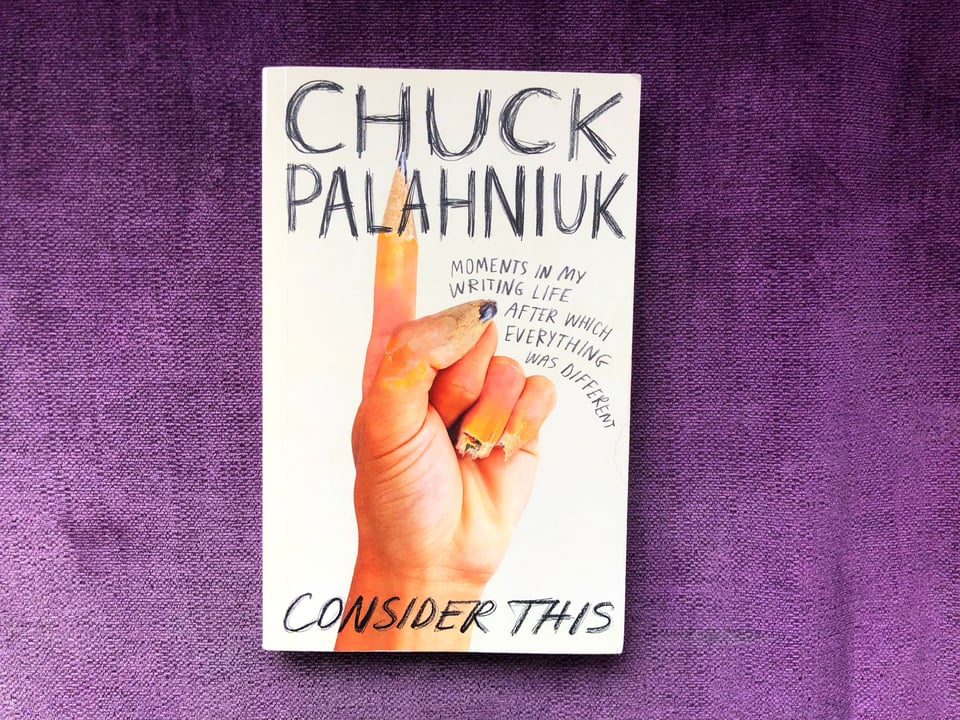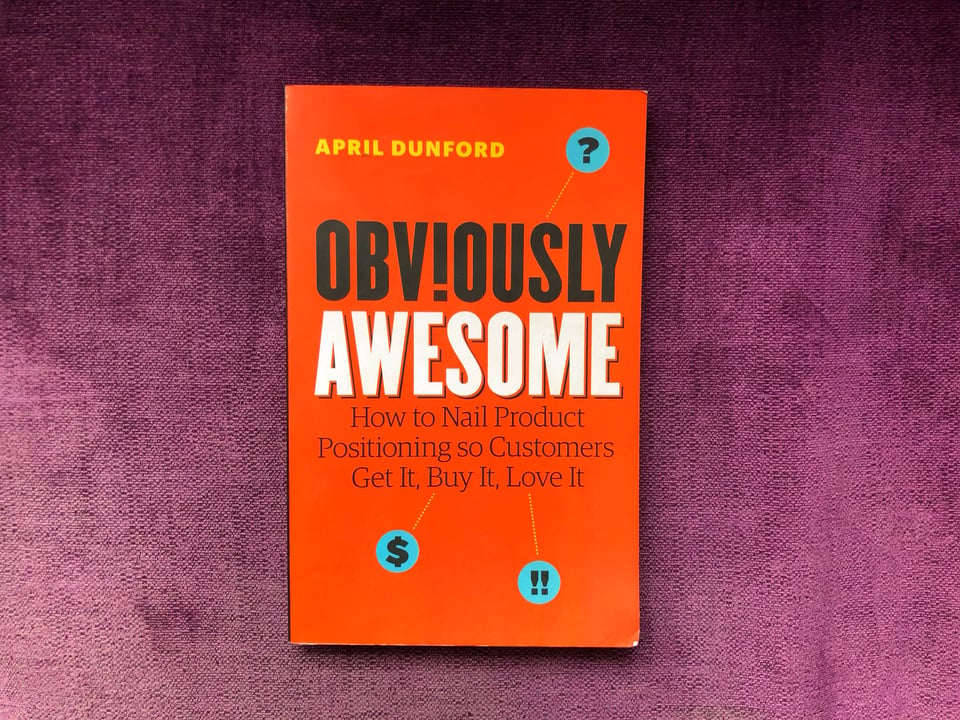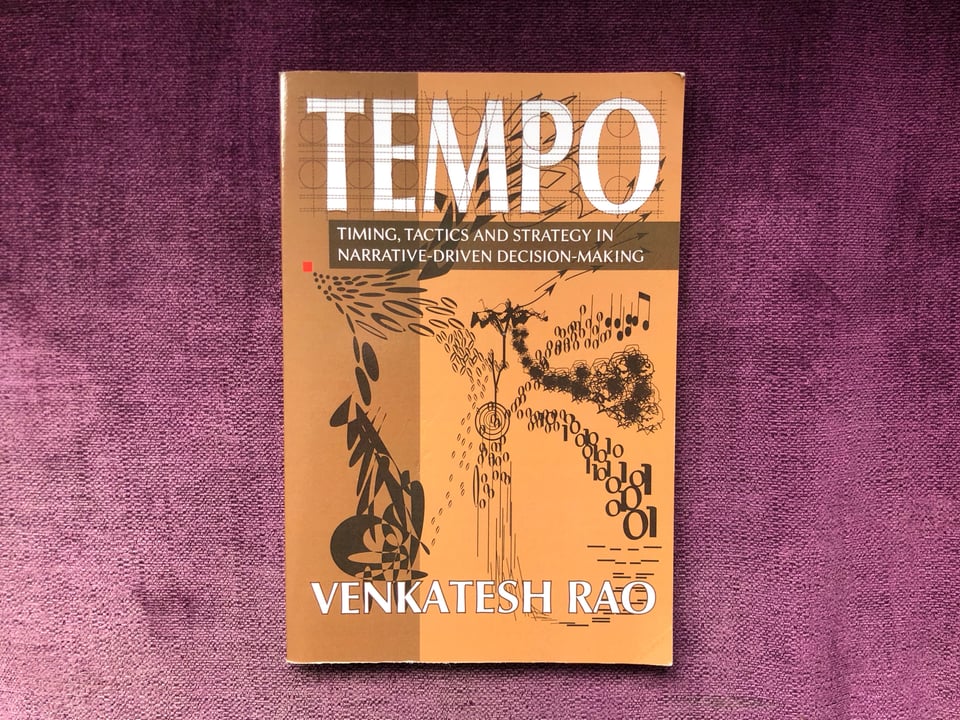After which everything was different
Some books that made me better.
Consider This by Chuck Palahniuk

I think I’ve read everything Chuck Palahniuk has ever written; every book at least. He’s one of a handful of writers about whom I can say that. He’s an ideas man. His novels all have a high-concept idea that he stretches on the rack until, with its dying breath, it screams its denouement at you. He pushes his ideas close to the pale, if not beyond for some people’s tastes. His exploration of dark, dirty places is the storytelling equivalent of proctology. He explores with no mercy the consequences of flaws, foibles, and fetishes. He’s fast, furious, and funny. And he’s a dab hand at refrains. As he says, “The goal is to create a chorus appropriate to the character.”
The first rule of Fight Club…
Chuck Palahniuk, Fight Club
He’s also a generous student of his craft. The subtitle to Consider This is “Moments in my writing life after which everything was different.” It’s non-fiction. It’s part memoir and part instruction manual. All of the “moments” in the subtitle are lessons he learned the hard way. It’s some of the best writing advice I’ve ever read, but he’s wary about giving it. He’d prefer us to learn the hard way too. So he creates another refrain to hide behind. He’d rather not offer advice, “But if you were my student, I’d tell you to…”
It’s a book of wee gems. Here are a couple. This is one of his tips for writing with AUTHORITY:
Instead of writing about a character, write from within the character.
This means that every way the character describes the world must describe the character's experience. You and I never walk into the same room as each other. We each see the room through the lens of our own life. A plumber enters a very different room than a painter enters.
This means you can't use abstract measurements. No more six-foot-tall men. Instead you must describe a man's size based on how your character or narrator perceives a man whose height is seventy-two inches. A character might say "a man too tall to kiss" or "a man her dad's size when he's kneeling in church."
Chuck Palahniuk, Consider This
And this is from a series of observations on different TEXTURES of writing:
Think of a good joke. "Yesterday I walked into a bar. You know how it goes. You walk into a bar, and you expect a bartender, maybe some video poker. A man needs his distractions. No guy wants to get off work and go into some bar and see a penguin mixing drinks..."
In conversation we switch between first-, second-, and third-person points of view. The constant shift controls the intimacy and authority of our story; for instance, "I walked" has the authority of the first person. Second person addresses the listeners and enlists them: "You walk." And the shift to third person controls the pace, "No guy wants," by moving from the specific "I" to the general "guy".
Chuck Palahniuk, Consider This
In addition to the digestible and doable advice, there are some weird and wonderful anecdotes from a life of writing. The unintended consequences of incitements he used to spice up book tour events are hilarious. Palahniuk lives his life like a character from one of his own stories. He’s his own protagonist.
He’s made me better. I think about texture and authority and other such things every time I write, particularly in the edit. Can’t you tell?
Obviously Awesome by April Dunford

This might be the best title of any business book I’ve ever read. Obviously Awesome is a book about positioning. And what else do you want from a positioning, other than to make it obvious that your product or service is awesome? Voilà! QED, before you’ve even opened the front cover.
Also, subtitles are important. “How to Nail Product Positioning so Customers Get It, Buy It, Love It,” is a worthy support act. It’s as cocky and chipper as the main title. It’s easy to go through the motions and let a book down with its subtitle, as you’ll see below.
I’m a simple soul. Keeping things simple is how I like to live. It’s how I like to work. Any clients reading this will know that I aim for the fewest possible components in a brand strategy.
April Dunford made me better in this respect. She opened the door to a simpler, less constipated, and more useful way of thinking about positioning. She’s that rarest of things in the strategy world: an original thinker. She’s also a heretic. She dares to question the standard-issue positioning statement. In fact she takes a hatchet to it.
Enter the positioning statement. Somewhere along the way, we have confused teaching people how to do positioning with teaching people how to write down positioning.
April Dunford, Obviously Awesome
This is music to my ears. I hate it when brand strategy means filling in boxes on a fixed template. And the quote above introduces a section of the book titled: Why You Should Never Create a Positioning Statement.
She proceeds with a brutal but entirely sensible take-down of positioning statements. And then she proposes her alternative, also entirely sensible, approach to positioning.
Her ideas are deceptively simple. For example:
Positioning is the act of deliberately defining how you are the best at something that a defined market cares a lot about.
April Dunford, Obviously awesome
There’s a lot to unpick in that sentence. A lot of important research and thinking and sacrifice to be done.
A friend of mine used to say, “Hey Phil, we’re parking in the same garage,” (American pronunciation) when he and I agreed on something important. Dunford and I are parking in the same garage when it comes to target market definition, particularly for B2B clients:
Your target market is the customers who buy quickly, rarely ask for discounts and tell their friends about your offerings.
April Dunford, Obviously Awesome
My process, such as it is, is about talking to a representative sample of my client’s best customers.
And Dunford captures, in another straightforward but profound observation, what you always find when you talk to a sample of customers:
It's important to remember that although you have unique attributes that deliver value to customers, not all customers care about that value in exactly the same way.
April Dunford, Obviously Awesome
Like Palahniuk, Dunford talks and advises from experience, sharing lessons learned the hard way. Her heretical ideas have worked in practice. Her framework is sensible and pragmatic. Obviously Awesome is an eye-opener that changed the way I think about positioning.
Tempo by Venkatesh Rao

Tempo looks like the kind of publication you’d only find in a university bookshop, for at least seventy quid. Its abstract cover art and its earnest subtitle give it a desktop-published PhD thesis aesthetic. It says esoteric. It says turgid. It hardly beckons you in.
These are false impressions. Definitely don’t judge this book by its cover.
On the inside, Tempo is fanciful and philosophical. It’s quirky and imaginative. It’s full of original and provocative ideas. When I first read it, I described it as being like a theory of relativity for how things get done in organisations.
I’m not saying it’s an easy read. It’s hard work in fact because it keeps confronting you with new ideas that take time to process. It’s like Understanding Media by Marshall McLuhan in this respect. One of McLuhan’s editors said of his book that, “75% of your material is new. A successful book cannot venture to be more than 10% new.” Reading Tempo was a similar experience to reading McLuhan. It’s the intellectual equivalent of hyperventilating. Slow-breathe into a paper bag after each chapter.
But it’s good for you. It was good for me at least.
Once I twigged how to recruit (I was a slow learner in this respect) I hired people whose world view was different to mine, who brought a surprising or provocative perspective to our interview conversations. It’s easier (but not easy) to recruit beautiful minds than it is to train them.
Buying this book was like recruiting one of those zesty original thinkers. Rao made me think again about many aspects of corporate culture.
His topics include Momentum, Mental Models, Metaphor, Doctrines, Design, and Archetypes. His ideas on each concept are always fresh and sometimes dissonant (in a good way.) Archetypes get a bad rap in brand strategy circles, but Rao makes them feel vital and pragmatic.
Archetypes are critical. We couldn't function without them, and conversations again illustrate this well. In a courtroom situation, the defendant might be thinking of himself as Victim, or can-beat-the-system guy and might view the prosecutor as Machiavelli or truth seeker. If we didn't have these efficient models in our head, conversations would be interspersed with silences of minutes, rather than tenths of seconds. Archetypes operating in conversations modulate the tempo of our decision making…
Archetypes are an artistic thinking tool, not a dictionary.
Venkatesh Rao, Tempo
For me, the most radical idea in the book is Narrative Time and how this relates to Style. Narrative Time is an event-based view of how we get from now to then.
Together rhythms and events help us think of time as material change. And if you think about it, this is the only way we can think about time. If things weren't changing, it is not clear that we'd experience a sense of time passing.
Venkatesh Rao, Tempo
Narrative Time is what made me think of relativity. How can a few seconds be exactly the same amount of time as several months? In Narrative Time they can. See the boxer/CEO example in the passage below.
The consistency you exhibit in your variations reveals your enactment style. Style is always a cumulative phenomenon revealed through repeated reinforcement. The specific narrative clock at work determines the minimum clock-time length of an epoch required to clearly reveal a style. A boxer may reveal his style in a few seconds. A new CEO may require a few quarters. In narrative time terms, however, the two epochs may be the same length. For instance, six punches for the boxer and six meetings for the CEO.
Venkatesh Rao, Tempo
My work for service businesses always involves an understanding of the culture behind the brand. Tempo gave me new tools and models to apply to that work.
Uncharted by Margaret Heffernan

You sometimes hear people criticise a business book by saying that it could and should have been a blog post. In other words, the idea might have value, but it doesn’t justify two hundred pages of padding to make it a book. We’ve all read a few of those. Uncharted isn’t one of them.
Like Tempo, Uncharted is an idea rush. And it’s not fair to call it a business book. It’s another consciousness expander. I saved a bunch of passages for future reference and the tags I used tell their own story about its scope: economics, propaganda, critical thinking, history, aesthetics, storytelling, context, ethics, innovation, democracy, scenario planning, culture, ambiguity, art, imagination, creativity, futures, complexity, leadership, data, and ethics. It’s like reading the ingredients on a cereal packet. Uncharted is “fortified” with a high percentage of your daily recommended intake of ideas.
The other thing Uncharted has in common with Tempo is an insipid subtitle that could have been written by SEO software. But that’s the only negative thing I have to say about the book.
Heffernan is another heretic. Uncharted makes it ok to not be ok about everything having to be ordered, efficient, predictable, and proven. Uncharted makes ok to not be ok with everything being data-driven. Uncharted makes it ok to be ok with ambiguity and to have an operating system based on imagination and daydreaming rather than just backward-looking numbers.
While loose structures might frustrate lovers of managerial neatness, it can allow leaders to arise from unpredictable places. Efficiency can be lethal; only the extravagant over-supply of creative thinking rises to meet the challenge.
Margaret Heffernan, Uncharted
For readers like me, Heffernan is preaching to the gallery. Readers like me need that sometimes; a quantum of validation. It’s a reassuring read for anyone who boldly goes on their wits and instinct. Just like Marshall McLuhann, Heffernan puts more faith in artists than analysts to make sense of the future.
If artists have the capacity to make work that defies time, it is because instead of trying to force-fit a predetermined idea of the future, they have learned to live productively with ambiguity, to see it as a rich source of discovery and exploration. Instead of trying to reduce complexity, they mine it, undaunted by contradictions and paradoxes.
Margaret Heffernan, Uncharted
Uncharted made me feel better about how I go about my work. You should aim off, therefore, for a quantum or two of confirmation bias.
Unlike expedient work, imagination doesn't move directly from observation to action but from noticing to gestation.
Margaret Heffernan, Uncharted
Uncharted is a book about how to explore, attack, and make the future. It draws on eclectic case studies from scientific research, industry, activism, and epidemiology. Taming the future is impossible. Uncharted concludes that you shouldn’t want to. It debunks the idea of history repeating itself. It laughs in the face of forecasts. It spits its tea at certainty. It’s not a comfortable read for the futurist community. But it’s succour for creatives.
Bonus reading list
There used to be a useful hashtag on Twitter: #PlannerRead. Or maybe it was the plural: #PlannerReads. I can’t remember. Agency planners and strategy folk generously sharing the good stuff. The quality control was excellent. I do remember that. And in that spirit, here are some books that I consider worthy of the hashtag.
How Music Works by David Byrne: No subtitle for this book but an alternative title could be How Creativity Works. Page after page of insight and reassurance about the chaotic, serendipitous nature of creativity. Observations on the importance of context that I go back to time and again. And a sublime chapter called How to Make a Scene, in which Byrne deconstructs the circumstances, policies, and happy design accidents that led to CBGB becoming the centre of an insanely influential music scene in the Seventies.
On Connection by Kae Tempest: An artist thinking deeply about what they do and why it’s important. How to connect with language. How to connect in person. What it means to connect in both ways at once. It’s beautiful and profound. It doesn’t need a subtitle and it hasn’t got one.
Words That Work by Frank Luntz: Probably the most famous and most influential pollster in the world. Not my cup of tea politically, but a brilliant thinker on issue framing and messaging - “If your principles match their values, the details won’t matter.” He spends his life talking to everyday Americans and observing how specific words and phrases either resonate or alienate. The book’s subtitle is perhaps the first principle for anyone in the communication business: “It’s not what you say, it’s what people hear.”
Prisoners of Geography by Tim Marshall: More than anything, this book is a reminder to focus on the fundamentals in any situation. Africa doesn’t have natural harbours or navigable rivers. There’s a vast, indefensible flat plain on Russia’s west. Melting Arctic ice is a geopolitical issue as well as an environmental catastrophe. Strategy doesn’t tinker round the edges. It deals with harsh, fundamental realities.
The Culture Map by Erin Meyer: A book that keeps the promise made by its title. It gives you a simple model for mapping cultures, whether for a nation or a corporation. It also contains some useful ideas about high and low-context language. And one of my favourite metaphors:
Before Japanese company members sign off on a proposal, consensus building starts with informal, face-to-face discussions. This process of informally making a proposal, getting input, and solidifying support is called nemawashi. Literally meaning "root binding," nemawashi is a gardening term that refers to a process of preparing the roots of a plant or tree for transplanting, which protects them from damage. Similarly, nemawashi protects a Japanese organisation from damage caused by disagreement or lack of commitment and follow-through.
Erin Meyer, The Culture Map
A Swim in the Pond in the Rain by George Saunders: This is one of my favourite books to buy for other people. It’s a mindful approach to understanding stories: how they unfold and how we react to them. Saunders is a Booker Prize winner and a professor of creative writing at Syracuse University. This book is him teaching creative writing in print, using short stories from the Russian masters as his curriculum. He keeps it simple and sensible. You can feel yourself becoming a more conscious reader. Beautiful.
We might imagine structure as a form of call-and-response. A question arises organically from the story and then the story, very considerately, answers it. If we want to make good structure, we just have to be aware of what question we are causing the reader to ask, then answer that question.
George Saunders, A Swim in the Pond in the Rain
P.S.
Hello and thank you to the influx of new readers who subscribed in the last few weeks. I’m assuming you’re mostly here on the back of my fifth birthday post: It helps if you know what you’re doing. It seems to have gone down well. I hope this newsletter continues to go down well with you.
Maybe try this too: Mixtaping my metaphors, a mixtape of metaphors and thoughts about metaphors.

Add a comment: